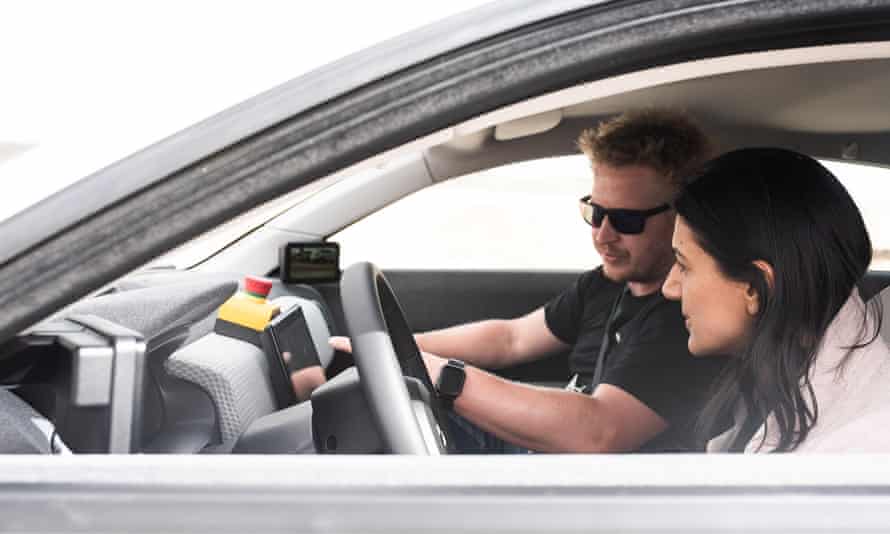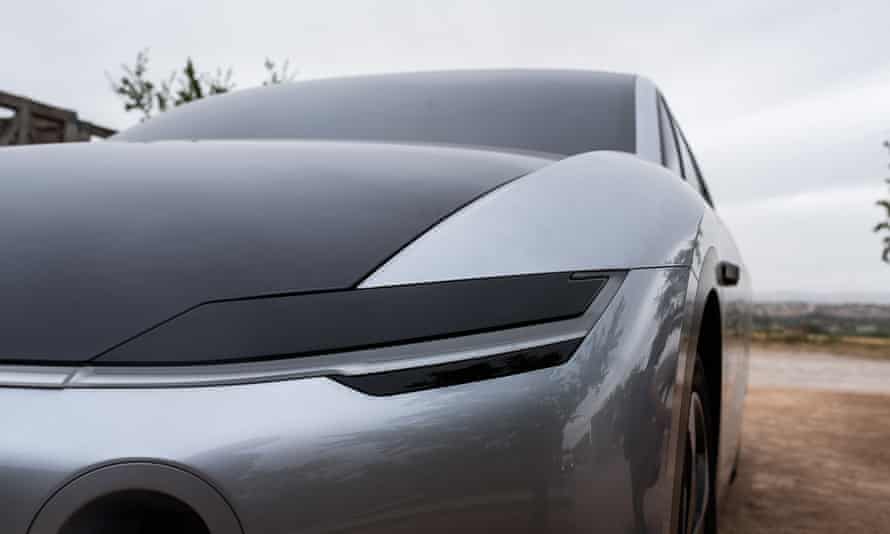Winding along the ocher plateau of the Bardenas Reales Natural Park in northern Spain, Roel Grooten prompted me to take my feet off the gas.
The car continued to move on the open section of the road, its speed decreased only slightly. “It’s still going,” said Grooten, a senior engineer at Dutch car company Lightyear, as we passed through the lunar landscape. “What you feel doesn’t stop you. You feel the aerodynamics, you feel the low rolling resistance of the tires, the bearings and the engine. ”
It is this streamlined design that the company acknowledges that it allows it to make its way into a space long neglected by most car manufacturers. As early as November, the company will begin delivery of what he describes as “the world’s first ready-to-manufacture solar car” – Lightyear 0, a sedan for 250,000 euros (215,000 British pounds), draped in 5 square meters of curved solar panels that charge the electric battery while the car is moving or parked outdoors.
“If we have the same amount of energy that we collect from these panels of any other car that uses three times more energy to drive, it becomes useless. This is becoming a very expensive trick, “Gruten said. “You have to build this car from the beginning to make it as efficient as possible, to make it so feasible.”
Under optimal conditions, solar panels can add up to 44 miles per day to the range of 388 miles that the car receives between charges, according to the company. Tests performed by Lightyear suggest that people with a daily commute of less than 22 miles to work can drive for two months in the Netherlands without having to plug in, while those in sunnier climates such as Portugal or Spain can last up to seven months.

But whether the company’s gambling on solar energy will pay off remains to be seen, said Jim Sacker, an honorary professor at Loughborough University and president of the Automotive Institute.
“You have to pay an awful lot of money and put solar panels on the car for only an extra 44 miles. The sign in question at the moment is the fact that is it really worth it? The real concept is not bad. Just whether the technology is really viable to make it economically viable for anyone who wants to do it. “
Lightyear 0 sales are likely to be limited to a handful of early users, he added. “But it’s not really a commercial offer right now.”
Others have questioned the idea of a car being touted as an ointment against the deepening climate crisis. “The surest way to approach car ownership is to avoid it altogether, if you can,” said Vera O’Reardon, a PhD student focusing on low-carbon roads and passenger transport policies at University College Cork in Ireland.
Although electric vehicles may play a limited role in rural areas where public transport is lacking, it is cites a study that suggests these vehicles are often sold to high-income households in urban areas. “So you have to ask yourself: do you serve this individualized, very inefficient, very harmful and traffic-provoking transport in urban areas, where it could otherwise be completely met by public transport and walking and cycling?”
The need to move away from cars to deal with climatic emergencies is being repeated – perhaps surprisingly – by Lex Hofslout, the 31-year-old CEO of Lightyear, who has raised around € 150 million to work.
“It would be great, I totally agree,” he said. “But I don’t think we’re going to change our lives too much. Maybe when we really panic in 20 years, we could. But in the meantime, we need to get around that. “
Since 2016, the company has supported solar energy as a key part of this bypass, imagining solar cars capable of running on clean energy and accelerating the transition from polluting fossil fuels. “People said it wasn’t possible, mostly because of the limited amount of solar energy you could get in a car,” Hofslout said.

However, his own experience suggests otherwise. Lightyear 0 – elegant four-wheel drive – originates from a squat box on wheels who transported four helmeted students to the Australian outback to win their class in the 2013 Solar Energy Challenge.
“If he works in Australia, then he works everywhere. That was the thinking, “said Hofslout, who co-founded Lightyear with four other members of the solar challenge team. “I have to admit that in the beginning there was hesitation whether to start full production of cars, because we all know that this is not the easiest thing. But there was no one else who really wanted to do something like that. “
In recent years, there has been a growing interest in the integration of solar panels in cars: Mercedes-Benz recently revealed plans to equip an upcoming electric car with solar panels on the roof while Toyota offers at times limited capacity solar panels in addition to its Prius hybrid.
The following year, the Munich-based Sono Motors deployment plans a € 28,500 solar-powered family car, while California-based startup Aptera Motors said in 2020 that pre-orders for its futuristic three-wheeled solar electric vehicle had sold out. in less than 24 hours.
With months to go before Lightyear 0 is produced, there are still breakages that need to be removed, from the hard steering wheel to the buzzing that sometimes fills the car when the air conditioning is turned on.
Once you’re in the car, there’s little about the driving experience that feels different from other electric cars – “It’s a huge compliment, it’s what we strive for,” one employee tells me – except for a few reminders of the constant drip solar power supply. One screen shows exactly which cells are fed by the sun at a given time, while another quantifies how much solar energy is absorbed.

In an effort to use as much of this solar energy as possible, the wind design avoids the side mirrors for cameras and works with light electric motors placed in its wheels. The body panels are made of regenerated carbon fiber, and the interior is made of vegan, vegetable skin with fabrics made from bottles of recycled polyethylene terephthalate.
The 20-minute test is probably the only time I’ll be behind the wheel of a Lightyear 0. With its huge price – ideally paid by those who have outdoor parking space to maximize the car’s profit from the sun – it’s not. car for the tables.
Instead, the company envisions production, which will offer up to 946 vehicles for delivery across Europe and the United Kingdom, as a start. “This is a small scale to confirm to the world that we can make a car,” said Telian Franken, head of the prototype team.
From there, the company will shift its focus to a second solar electric car it aims to sell for around € 30,000 as early as 2025. “We are trying to make a difference, not for the millionaire who can afford a car for € 250,000, but to get us to the point where the average person a grille can come down – take a reliable, sustainable vehicle that outperforms any economical device you can get at the time, ”Franken said, citing the Toyota Corolla or Honda Accord as examples. “We’re trying to beat this – and replace it – because it’s not sustainable.”